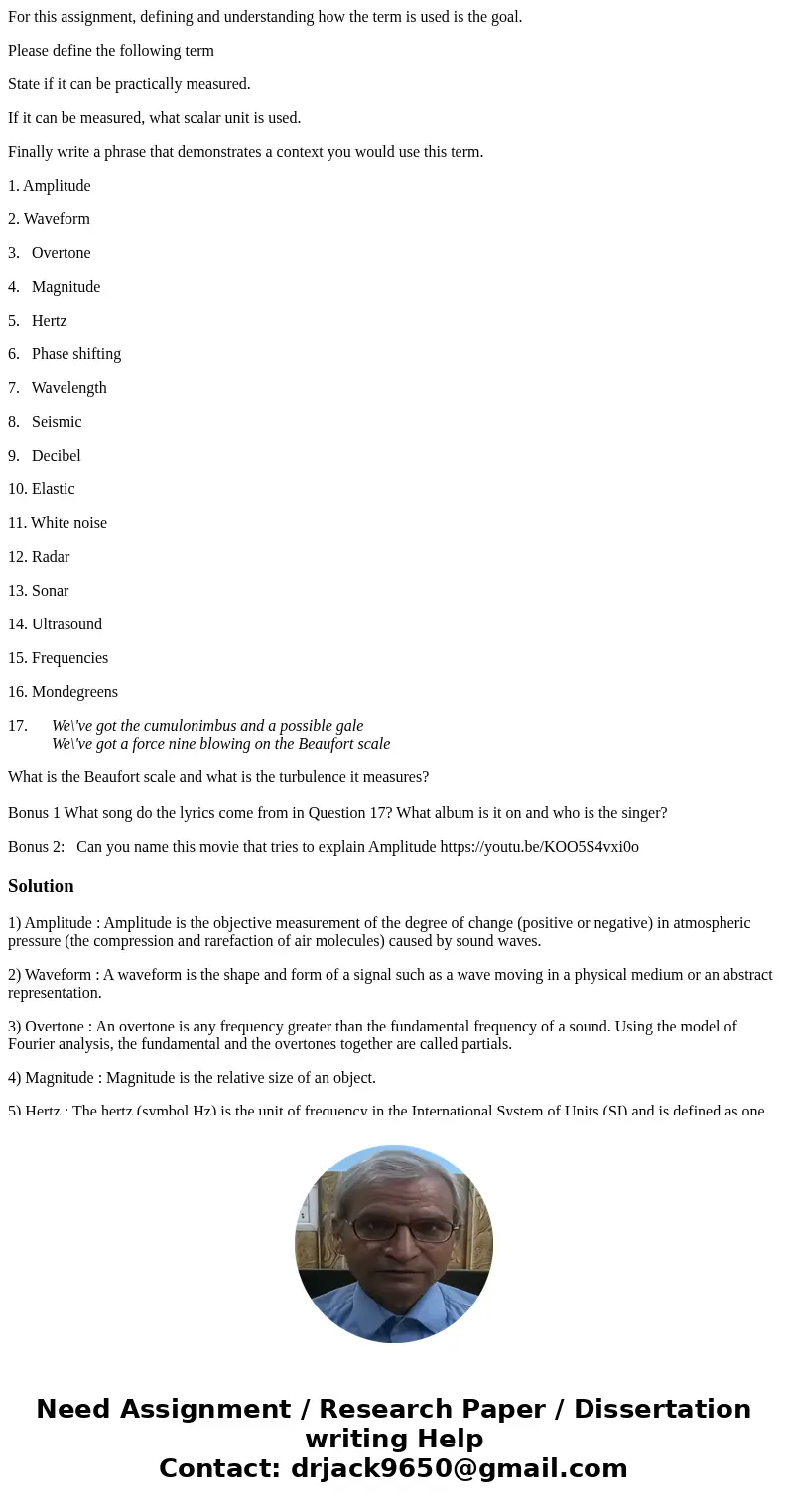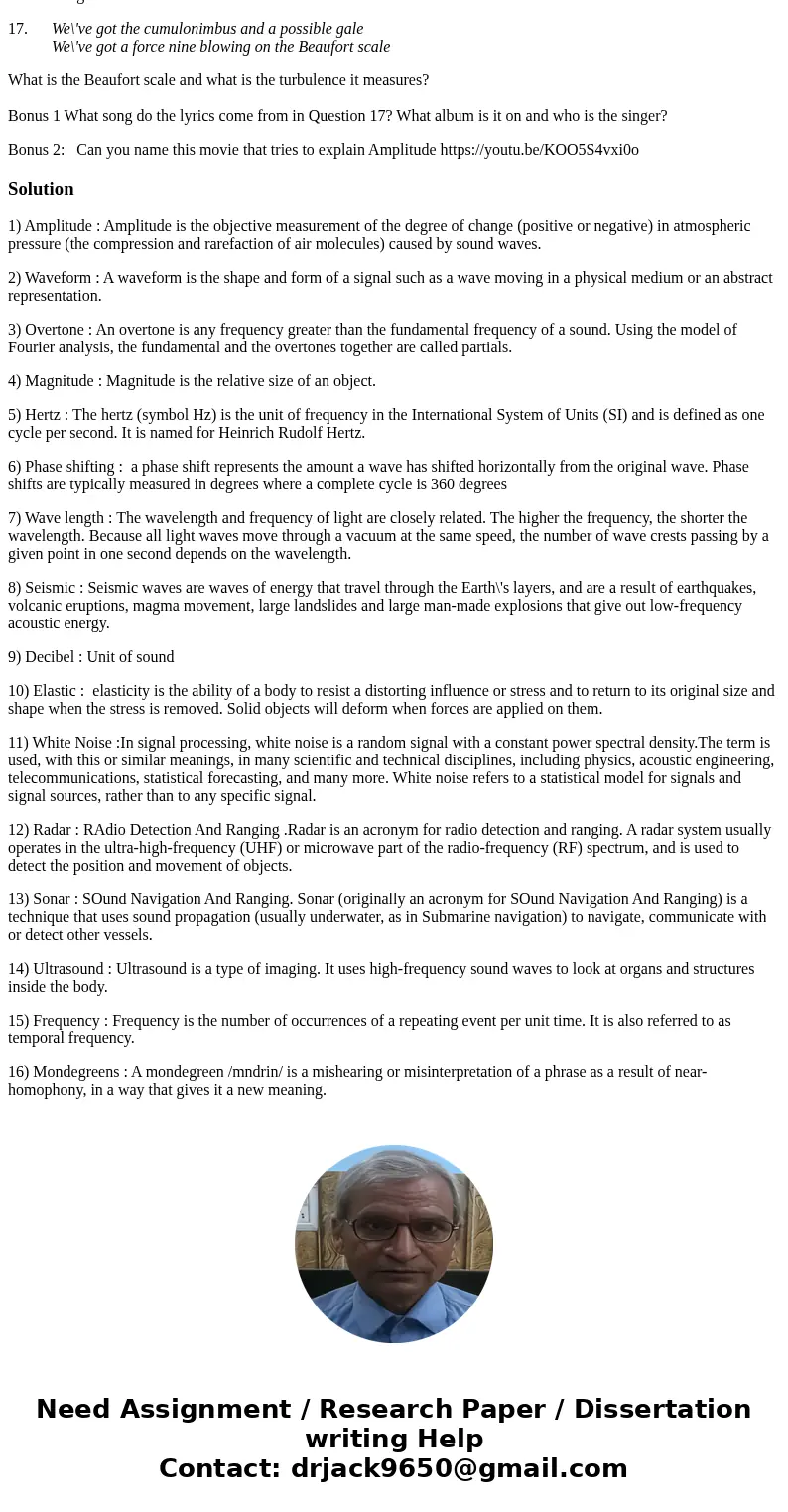For this assignment defining and understanding how the term
For this assignment, defining and understanding how the term is used is the goal.
Please define the following term
State if it can be practically measured.
If it can be measured, what scalar unit is used.
Finally write a phrase that demonstrates a context you would use this term.
1. Amplitude
2. Waveform
3. Overtone
4. Magnitude
5. Hertz
6. Phase shifting
7. Wavelength
8. Seismic
9. Decibel
10. Elastic
11. White noise
12. Radar
13. Sonar
14. Ultrasound
15. Frequencies
16. Mondegreens
17. We\'ve got the cumulonimbus and a possible gale
We\'ve got a force nine blowing on the Beaufort scale
What is the Beaufort scale and what is the turbulence it measures?
Bonus 1 What song do the lyrics come from in Question 17? What album is it on and who is the singer?
Bonus 2: Can you name this movie that tries to explain Amplitude https://youtu.be/KOO5S4vxi0o
Solution
1) Amplitude : Amplitude is the objective measurement of the degree of change (positive or negative) in atmospheric pressure (the compression and rarefaction of air molecules) caused by sound waves.
2) Waveform : A waveform is the shape and form of a signal such as a wave moving in a physical medium or an abstract representation.
3) Overtone : An overtone is any frequency greater than the fundamental frequency of a sound. Using the model of Fourier analysis, the fundamental and the overtones together are called partials.
4) Magnitude : Magnitude is the relative size of an object.
5) Hertz : The hertz (symbol Hz) is the unit of frequency in the International System of Units (SI) and is defined as one cycle per second. It is named for Heinrich Rudolf Hertz.
6) Phase shifting : a phase shift represents the amount a wave has shifted horizontally from the original wave. Phase shifts are typically measured in degrees where a complete cycle is 360 degrees
7) Wave length : The wavelength and frequency of light are closely related. The higher the frequency, the shorter the wavelength. Because all light waves move through a vacuum at the same speed, the number of wave crests passing by a given point in one second depends on the wavelength.
8) Seismic : Seismic waves are waves of energy that travel through the Earth\'s layers, and are a result of earthquakes, volcanic eruptions, magma movement, large landslides and large man-made explosions that give out low-frequency acoustic energy.
9) Decibel : Unit of sound
10) Elastic : elasticity is the ability of a body to resist a distorting influence or stress and to return to its original size and shape when the stress is removed. Solid objects will deform when forces are applied on them.
11) White Noise :In signal processing, white noise is a random signal with a constant power spectral density.The term is used, with this or similar meanings, in many scientific and technical disciplines, including physics, acoustic engineering, telecommunications, statistical forecasting, and many more. White noise refers to a statistical model for signals and signal sources, rather than to any specific signal.
12) Radar : RAdio Detection And Ranging .Radar is an acronym for radio detection and ranging. A radar system usually operates in the ultra-high-frequency (UHF) or microwave part of the radio-frequency (RF) spectrum, and is used to detect the position and movement of objects.
13) Sonar : SOund Navigation And Ranging. Sonar (originally an acronym for SOund Navigation And Ranging) is a technique that uses sound propagation (usually underwater, as in Submarine navigation) to navigate, communicate with or detect other vessels.
14) Ultrasound : Ultrasound is a type of imaging. It uses high-frequency sound waves to look at organs and structures inside the body.
15) Frequency : Frequency is the number of occurrences of a repeating event per unit time. It is also referred to as temporal frequency.
16) Mondegreens : A mondegreen /mndrin/ is a mishearing or misinterpretation of a phrase as a result of near-homophony, in a way that gives it a new meaning.


 Homework Sourse
Homework Sourse